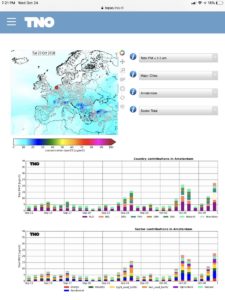Exposure to environmental pollution is thought to cause as many as 9 million premature deaths each year. The largest health impacts are associated with air pollutants and particulate matter in particular. The latter is thought to cause an average reduction in life expectancy of 6 to 12 months in Europe. EU limit and target values are still exceeded throughout the EU. Moreover, a large proportion of the urban population (82-85% for PM2.5 and 50-62% for PM10) is exposed to concentrations above the WHO air quality guideline values. In short, air pollution has wide-ranging effects on human health and well-being and affect European competitiveness and sustainable growth.
Reliable data
Reliable data about the origin of fine dust is needed. The TNO web application TOPAS provides policymakers and other interested parties with free insight into the origin of particulate matters and what type of source is responsible for more than two hundred European cities.
Particulate matters result from combustion of fuels, wear processes and the processing of materials. Natural sources such as sea salt and Sahara sand also contribute to the amount of particulate matter in the air. For effective air quality policy, it is important to know what the sources of particulate matter are in an area. Based on this, measures are then developed. Until recently, the so-called source allocation of particulate matter was, to a certain extent, ‘guesswork’ for policymakers. With the TNO TOPAS tool, this can now be made more reliable and simpler.
TOPAS
TOPAS is built on the basis of existing TNO knowledge, such as the atmospheric transport model LOTOS-EUROS. For TOPAS, this model is fed with information from weather models of the European Copernicus atmospheric monitoring system (CAMS). This prototype source apportionment service is a product based on the chemical transport model LOTOS-EUROS and the emission knowledge developed at TNO. Information on intercontinental transport and forest fire emissions are taken from the Copernicus Atmospheric Monitoring Service. Modeled source-specific PM concentrations representing urban background conditions are uploaded daily before noon.
Project leader Martijn Schaap: “TOPAS is still in beta. But it already offers the user a thorough picture of the development of particulate matter in the past six weeks. So you see for your own city from which countries the particulate matter concentration originates. In addition, we provide insight into which sector contributes to the particulate matter to what extent. Users see the relationship between, among other things, industrial origin, large-scale energy generation, traffic, and natural resources. The data is refreshed every 24 hours and offered for free.”
Source: TNO

